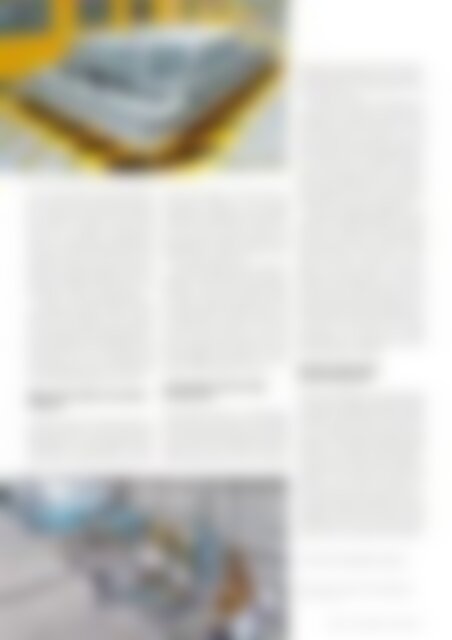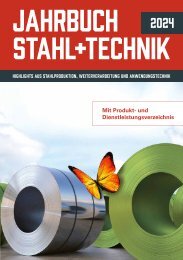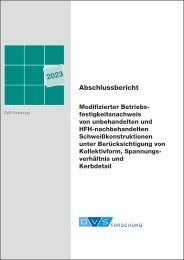STEEL + TECHNOLOGY 04/2019 EXTRACT
STEEL + TECHNOLOGY 04/2019 EXTRACT
STEEL + TECHNOLOGY 04/2019 EXTRACT
Create successful ePaper yourself
Turn your PDF publications into a flip-book with our unique Google optimized e-Paper software.
80 | <strong>STEEL</strong> PROCESSING<br />
Stack of laser cut blanks for car side panels (Picture: Schuler)<br />
cult to make a product somewhere else on<br />
short notice if you’re using a press blanking<br />
line. To do so, they first have to move the<br />
dies, prepare for shipment, and then send<br />
them off.” If a supplier is producing the<br />
blanks, the scrap chutes or something else<br />
may not fit. “With laser blanking lines in the<br />
production network, all I have to do is send<br />
a data set for the desired part and make sure<br />
that the coil material is available on-site. If on<br />
schedule, production can start one or two<br />
hours later. It’s really a huge advantage.”<br />
Fonteyne’s coworker Berthold Jüttner<br />
offers another example: “One of our customer’s<br />
plant managers had a problem<br />
with a blanking press and had asked another<br />
plant manager if he would be able to cut<br />
a few blanks for him on the latter’s laser<br />
blanking line. He then immediately sent<br />
the drawings and had the coils brought to<br />
the site. Blanking began the next day.”<br />
High surface quality and material<br />
utilization<br />
In addition to the newly achieved blank-programming<br />
freedom, Jüttner sees another<br />
advantage in the line’s excellent dimensional<br />
accuracy, reproducibility, and surface<br />
quality: “There are no burrs, and the<br />
amount of trumpery is much less than in<br />
conventional blanking.” The so-called<br />
“angel’s hair” phenomenon is especially<br />
prevalent where blanks are cut from aluminum<br />
coils, and is also the reason why<br />
blanking presses regularly need to stop to<br />
clean the dies. “This is no longer an issue<br />
with the laser blanking line.”<br />
Laser blanking also makes it possible to<br />
support the material across its entire surface<br />
area. “We can nest the parts edgeto-edge<br />
on the coil and no longer need the<br />
8- to 10-mm dividers required when using<br />
the blanking dies. For small cutouts, we<br />
can briefly open the belts and the scrap<br />
can drop into the scrap chute.” On the new<br />
lines, the scrap and good parts are no<br />
longer separated using robots, but rather<br />
by an intelligent sorting system. This provides<br />
an additional boost in output.<br />
Laser handle easily also highstrength<br />
steel<br />
The growing amount of high-strength<br />
steels used in automobiles is increasingly<br />
pushing blanking presses closer and closer<br />
to their maximum mechanical loads, adds<br />
Liebel, who notes: “When it comes to<br />
yield strengths, there are no limits in laser<br />
blanking. We have performed many tests,<br />
and high-strength steels are no problem.”<br />
As Jüttner puts it, “The laser doesn’t care<br />
at all what’s under it.”<br />
According to Liebel, the bundled beam<br />
of light darts across the metal coil at<br />
speeds of up to 100 meters per minute at<br />
a thickness between 0.7 and 2.5 mm. He<br />
adds, “Before the year 2000, it was only<br />
possible to achieve blanking speeds of 4<br />
or 5 meters per minute using CO 2 lasers.<br />
Then the fiber laser made its triumphant<br />
entrance and opened up the entire possibility<br />
of laser blanking for the first time.<br />
This development never would have been<br />
possible with conventional gas lasers.”<br />
What’s more: Noise emissions are much<br />
lower than with blanking presses. “If sound<br />
protection is installed on the laser blanking<br />
line, you’ll have to look very carefully to see<br />
whether the line is running or not,” Jüttner<br />
says with a laugh. “You can have a completely<br />
normal conversation, as long as a<br />
press isn’t running next to you.” The investment<br />
cost is also significantly lower, since<br />
the laser line is not as tall and also does not<br />
require an elaborate press foundation, says<br />
Jüttner, adding: “That’s a huge cost factor.”<br />
The loop for material buffer is also routed<br />
above-ground. The laser line’s energy<br />
requirements are comparable to those of a<br />
press blanking line, however.<br />
Software makes blank<br />
programming easier<br />
Schuler has developed a software package<br />
“LBL Studio” designed to greatly reduce<br />
the operator workload required to program<br />
the laser cutting movement. “All you have<br />
to do is upload the drawing data, and the<br />
program will calculate the best-possible<br />
contours, the possible nesting options,<br />
and the optimum level of laser utilization,”<br />
Fonteyne says as she lists the software’s<br />
benefits. “This means that users can<br />
already define the laser movement contours<br />
and configure the transitions offline.”<br />
The binding output quantities can also be<br />
predicted. “After that, the data can be<br />
transferred to the control system, and production<br />
can be run exactly as configured.”<br />
• Schuler AG, Göppingen, Germany<br />
Entry section of the laser blanking line<br />
(Picture: Schuler)<br />
<strong>STEEL</strong> + <strong>TECHNOLOGY</strong> 1 (<strong>2019</strong>) No. 4


















